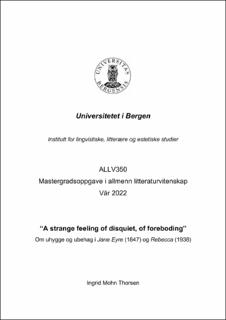| dc.contributor.author | Thorsen, Ingrid Mohn | |
| dc.date.accessioned | 2022-06-25T00:17:24Z | |
| dc.date.available | 2022-06-25T00:17:24Z | |
| dc.date.issued | 2022-05-20 | |
| dc.date.submitted | 2022-06-23T22:02:39Z | |
| dc.identifier.uri | https://hdl.handle.net/11250/3000794 | |
| dc.description.abstract | Denne avhandlingen tar for seg Jane Eyre (1847) av Charlotte Brontë og Rebecca (1938) av Daphne du Maurier. I løpet av oppgaven vil jeg sammenligne disse to romanene med utgangspunkt i rom og karakterer som har en uhyggelig effekt både på romanenes hovedkarakterer og på leseren. I forbindelse med dette vil jeg basere mye av analysen på Sigmund Freud og hans teorier om det uhyggelige. Gjennom oppgavens forløp kommer jeg frem til at det uhyggelige i forbindelse med rom og steder i stor grad kan knyttes til usikkerheten ved om det som skjer er ekte eller ikke. I forlengelse av å se på uhyggelige karakterer vil jeg også undersøke om det er en forskjell på uhyggelige og ubehagelige karakterer, og hvordan de eventuelt påvirker romanenes hovedkarakterer. Jeg vil også undersøke hvorvidt karakterene har noen innflytelse på rommene de er i, og se på om rommene som en effekt av dette vil gi et annet inntrykk enn de ellers ville gjort. I tillegg til dette diskuterer jeg en del kjennetegn ved gotiske romaner, og ser på hvorvidt de to romanene jeg analyserer passer til disse kjennetegnene. Jeg ser også på fortellerstilene i de to romanene, og kommer frem til at det at begge hovedpersonene er upålitelitelige fortellere i stor grad påvirker leserens inntrykk av de andre karakterene og har mye å si for hvordan de oppfattes. I konklusjonen av oppgaven viser jeg hva jeg har funnet ut av, og gir noen avsluttende kommentarer til hvordan uhyggelige rom og karakterer påvirker romanenes hovedpersoner og leseren. | |
| dc.description.abstract | In this thesis I will analyze the two novels Jane Eyre (1847) by Charlotte Brontë and Rebecca (1938) by Daphne du Maurier. Over the course of the thesis I will compare these novels to each other, based on uncanny rooms and characters that negatively affect the novels’ main characters and the reader. Furthermore, I will base much of my analysis on Sigmund Freud’s theories on the uncanny. Through my thesis I acknowledge the fact that when we look at uncanniness in rooms and places, this is often connected to an uncertainty about whether incidents are real or not. In addition to looking at uncanny characters I will also discuss the distinction between uncanny and unpleasant characters, and I will look at how they affect the main characters of the novels. In addition to this I will also be discussing how the characters influence the rooms they are in, and whether or not this leads to the rooms being perceived differently than they would have been otherwise. In addition to this, I will be looking at some characteristics of the Gothic novel and discussing whether the two novels I have chosen fit into these characteristics. In addition to this I will be discussing the narrators in the novels. Both the narrators in the novels are unreliable narrators, and I will argue that this greatly influences the reader, and affects how we view and perceive the other characters. In the conclusion I will present my findings, as well as give a few closing statements as to how uncanny rooms and characters affect the main characters and the reader. | |
| dc.language.iso | nob | |
| dc.publisher | The University of Bergen | |
| dc.rights | Copyright the Author. All rights reserved | |
| dc.title | “A strange feeling of disquiet, of foreboding” Om uhygge og ubehag i Jane Eyre (1847) og Rebecca (1938) | |
| dc.type | Master thesis | |
| dc.date.updated | 2022-06-23T22:02:39Z | |
| dc.rights.holder | Copyright the Author. All rights reserved | |
| dc.description.degree | Allmenn litteraturvitenskap mastergradsoppgave | |
| dc.description.localcode | ALLV350 | |
| dc.description.localcode | MAHF-LITT | |
| dc.subject.nus | 712103 | |
| fs.subjectcode | ALLV350 | |
| fs.unitcode | 11-21-0 | |
